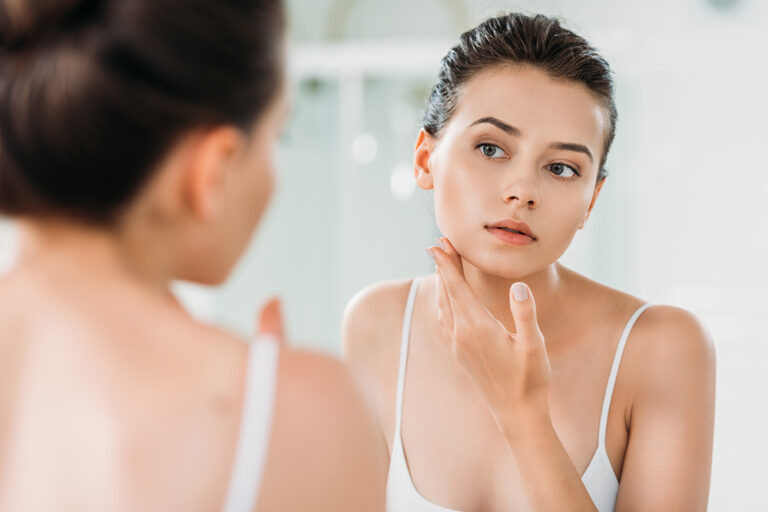acne

Do you continue to break out despite having tried several acne treatments? Are you convinced that nothing’s going to work, but given time, the acne will clear on its own? You don’t have to wait. With the right treatment and skin care, virtually everyone can see clearer skin. At Annexus Dermatology & Aesthetics our Dermatology Providers led by Dr. Neil Sandhu, MD, FAAD, provide customized acne treatment plans to bring back your clear skin and confidence. Call Annexus Dermatology & Aesthetics or book an appointment online to find the most effective acne treatment for you.
Call Today! 386-628-DERM (3376)
Acne Q&A
Acne Treatment for Annexus Dermatology & Aesthetics
Acne is the most frequent skin condition seen by medical professionals. It consists of pimples that appear on the face, back, and chest. About 80% of adolescents have some form of acne, and about 5% of adults experience acne. In normal skin, oil glands under the skin, known as sebaceous glands, produce an oily substance called sebum.
What does Acne Look Like?
- Whiteheads/Blackheads, also known as comedones, are non-inflammatory and appear more on the face and shoulders. As long as they remain uninfected, they are unlikely to lead to scarring.
- Red Pustules or Papules are inflamed pores that fill with pus. These can lead to scarring.
Causes of Acne
In normal skin, oil glands under the skin, known as sebaceous glands, produce an oily substance called sebum. The sebum moves from the bottom to the top of each hair follicle and then spills out onto the surface of the skin, taking with it sloughed-off skin cells. With acne, the structure through which the sebum flows gets plugged up. This blockage traps sebum and sloughed-off cells below the skin, preventing them from being released onto the skin’s surface. If the pore’s opening is fully blocked, this produces a whitehead. If the pore’s opening is open, this produces blackheads. When either a whitehead or blackhead becomes inflamed, they can become red pustules or papules. It is important for patients not to pick or scratch at individual lesions because it can make them inflamed and can lead to long-term scarring.
how do dermatologists treat acne?
Treating acne is a relatively slow process; there is no overnight remedy. The acne treatment plan that’s right for you depends on many considerations, including:
- What type of acne (i.e., blackheads, pimples, etc.) you have
- Where the acne appears on your skin
- What treatments you’ve already tried
- When the breakouts started
- Your age
- Whether the acne has left you with dark spots or scars
A treatment plan can vary from one patient to the next, even for 2 patients who have the same type of acne. If you have these whiteheads, blackheads, or breakouts, you’ll likely apply acne medication to your skin. Your treatment plan may include one of the following:
- Benzoyl Peroxide— Used in mild cases of acne, benzoyl peroxide reduces the blockages in the hair follicles.
- Oral and Topical Antibiotics— Used to treat any infection in the pores.
- Hormonal Treatments— Can be used for adult women with hormonally induced acne.
- Tretinoin— A derivative of Vitamin A, tretinoin helps unplug the blocked-up material in whiteheads/blackheads. It has become a mainstay in the treatment of acne.
- Extraction— Removal of whiteheads and blackheads using a small metal instrument that is centered on the comedone and pushed down, extruding the blocked pore.
Women who continue to get breakouts may need medication, such as a birth control pill that the U.S. Food and Drug Administration (FDA) has approved to treat acne. The birth control patch may also be effective, as can some other medications.
Acne nodules and cysts: If you have deep, painful acne that often leaves a permanent acne scar, effective treatment can help you see clearer skin and prevent new scars. Treatment may consist of:
- Prescription medication that you apply to your skin + taking an antibiotic
- Hormonal therapy (women only)
- Isotretinoin (medication approved to treat severe acne)
Sometimes Acne Needs Extra Help
To help you get the best possible results from treatment, your dermatologist may also recommend adding one of the following to your treatment plan.
Laser or light therapy: Studies show that laser and light devices can help to clear acne. This type of treatment works best when combined with other acne treatment.
A corticosteroid injection: If you have a large, extremely painful and deep acne breakout, a dermatologist can inject it with a corticosteroid. This can rapidly relieve the pain and the size of the breakout. While effective, this treatment is reserved for treating a few severe acne breakouts. Using it more than a few times can cause side effects.
Microdermabrasion, Microneedling, Chemical Peels, Facials
Once you get the results you want, follow-up appointments with your dermatologist may seem unnecessary. You want to keep those appointments. Without treatment, many people see breakouts for years. To prevent this, your dermatologist will give you a different treatment plan.
Want more information on acne treatment from Annexus Dermatology & Aesthetics.
Call our office at 386-628-3376 to learn more


